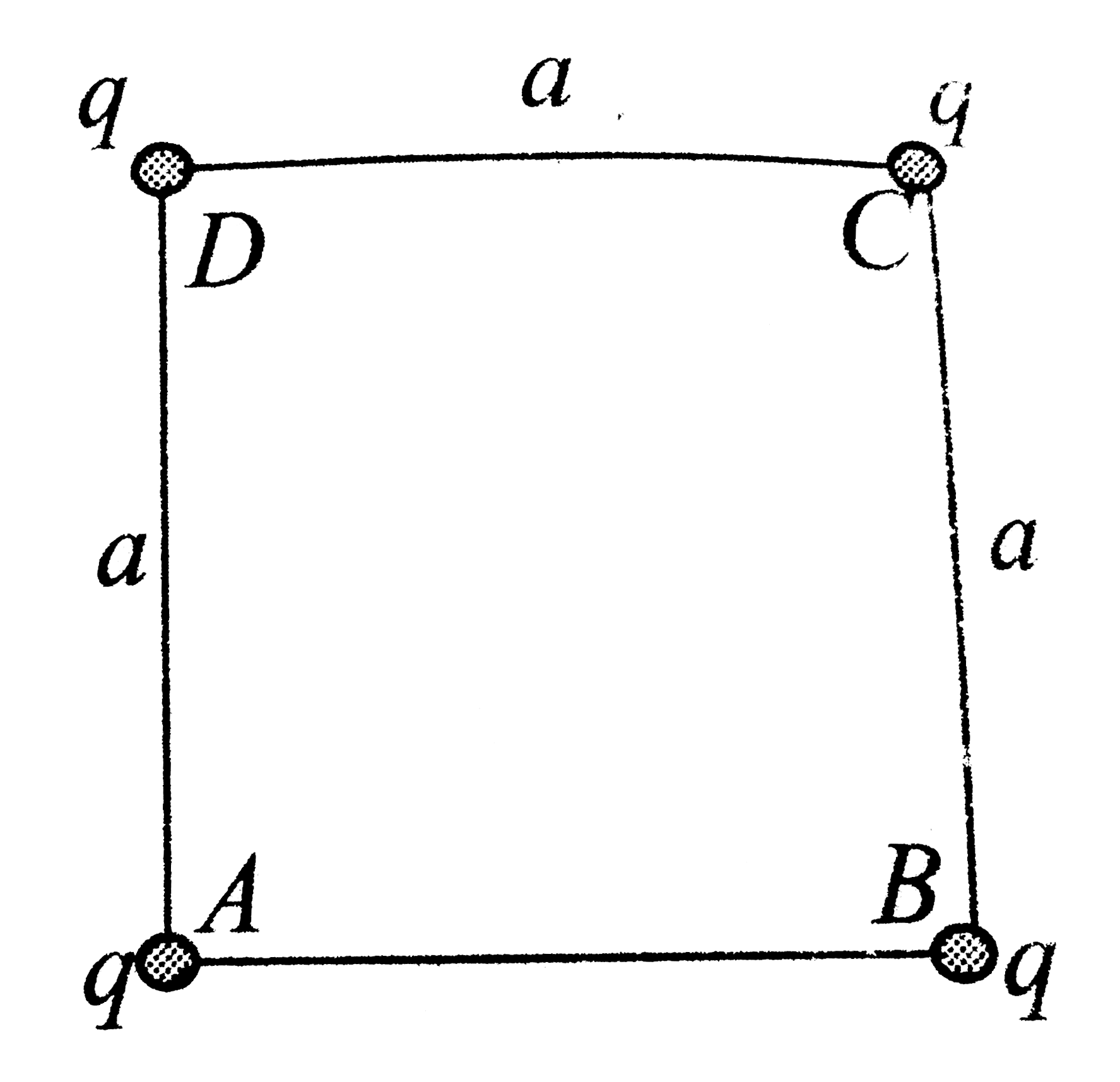Find the electric field and potential at the centre of a square of side d = 10 cm. Four identical charges of q=2μC each are kept at the four corners of a square.
To find the electric field and potential at the center of a square with side length d=10cm and four identical charges q=2μC placed at the corners, we can follow these steps:
Step 1: Understand the Geometry
The square has a side length d=10cm=0.1m. The center of the square can be found by drawing the diagonals, which intersect at the center.
Step 2: Calculate the Distance from the Center to Each Charge
The distance from the center of the square to each corner (where the charges are located) can be calculated using the Pythagorean theorem. Each half of the square's side is d2=0.05m. Thus, the distance r from the center to a corner is:
r=√(d2)2+(d2)2=√(0.05)2+(0.05)2=√0.0025+0.0025=√0.005=0.0707m
Step 3: Calculate the Electric Field Due to One Charge
The electric field E due to a single charge q at a distance r is given by:
E=kqr2
where k=14πϵ0≈9×109N m2/C2.
Substituting the values:
E=9×109×2×10−6(0.0707)2=18×1030.005=3.6×106N/C
Step 4: Determine the Direction of the Electric Field
Since all charges are positive, the electric field vectors due to each charge will point away from the charges. The symmetry of the square means that the electric fields due to opposite charges will cancel each other out.
Step 5: Calculate the Net Electric Field
By symmetry, the electric fields from opposite corners will cancel out:
Enet=EA+EB+EC+ED=0
Step 6: Calculate the Electric Potential at the Center
The electric potential V due to a single charge at distance r is given by:
V=kqr
For four charges, the total potential at the center is:
Vnet=VA+VB+VC+VD=4⋅kqr
Substituting the values:
Vnet=4⋅9×109×2×10−60.0707=4⋅18×1030.0707≈4⋅254.95×103≈1.0198×106V≈1.02×106V
Summary of Results
- Electric Field at the center: Enet=0N/C
- Electric Potential at the center: Vnet≈1.02×106V
The square has a side length d=10cm=0.1m. The center of the square can be found by drawing the diagonals, which intersect at the center.
The distance from the center of the square to each corner (where the charges are located) can be calculated using the Pythagorean theorem. Each half of the square's side is d2=0.05m. Thus, the distance r from the center to a corner is:
The electric field E due to a single charge q at a distance r is given by:
Since all charges are positive, the electric field vectors due to each charge will point away from the charges. The symmetry of the square means that the electric fields due to opposite charges will cancel each other out.
By symmetry, the electric fields from opposite corners will cancel out:
The electric potential V due to a single charge at distance r is given by:
- Electric Field at the center: Enet=0N/C
- Electric Potential at the center: Vnet≈1.02×106V
Topper's Solved these Questions
- ELECTROSTANTICSBook:FIITJEEChapter:ELECTROSTANTICSExercise:SOLVED PROBLEMS (SUBJECTIVE)
Explore 10 Videos
- ELECTROSTANTICSBook:FIITJEEChapter:ELECTROSTANTICSExercise:SOLVED PROBLEMS (OBJECTIVE)
Explore 15 Videos
- ELECTROMAGNETIC WAVE & WAVE OPTICSBook:FIITJEEChapter:ELECTROMAGNETIC WAVE & WAVE OPTICSExercise:ASSIGNMENT PROBLEMS Objective : Level-II (MULTI CHOICE SINGLE CORRECT)
Explore 21 Videos
- ELECTROSTATICSBook:FIITJEEChapter:ELECTROSTATICSExercise:Example
Explore 14 Videos
Similar Questions
Calculate the electric potential at the center of a square of side √2m, having charges 100μc,−50μC,20μcand−60μC at the four corners of the square.
View SolutionA500μC charge is at the centre of a square of side 10 cm. Find the work done in moving a charge of 10μC between two diagonally opposite points on the square.

View Solution
Knowledge Check
The gravitational potential at the centre of a square of side a when four point masses m each are kept at its vertices will be
A4√2GmaB−4√2GmaC2√2GmaD−2√2GmaThe electric field at the centre of a square having equal charge q at each of the coner (side of square a )
A8kqa2B2kqa2CzeroD4kq(a/√2)2Two positive charges of magnitude q are placed at the ends of a side ( side 1) of a square of side 2a . Two negative charges of the same magnitude are kept at the other corners . Staring from rest , n a charge Q moves from the middle of side 1 to the centre of square , its kinetic energy at the centre of square is -.
A14π∈02qQa(1+1√5)B14π∈02qQa(1+1√5)C14π∈02qQa(1+1√5)D14π∈02qQa(1+1√5)
Four point charges are placed at the corners of a square ABCD of side 10 cm, as shown in figure. The force on a charge of 1μC placed at the centre of square is

View Solution[" 4.Four point charges "q_(A)=2 mu C" and "q_(B)=-5 mu C,q_(C)=],[2 mu c" and "q_(D)=-5 mu c" are located at the corners of a "],[" square "ABCD" of side "10cm" .What is the force on a "],[" charge of "2 mu c" placed at the centre of the square? "]
View SolutionFour identical charges q are placed at the corners of a square of side a. Find the potential energy of one of the charges due to the remaining charges.
 .
.
View SolutionFour point charges are placed at the corners of a square of side l. Calculate potential at the centre of square.

View SolutionTwo point charges +Q each are placed at adjacent corners of a square. Other two point charges -Q each are placed at the remaining two corners of the same square . The side of the square is l. Find electric field intensity at the centre of the square.
View Solution

